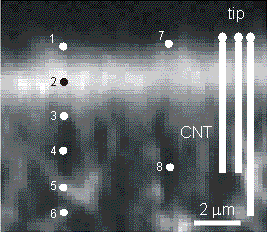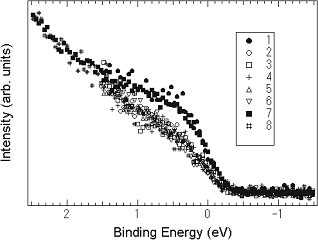Device Physics Laboratory
Å@Carbon nanotubes (CNTs) have attracted attention primarily because of the unique one-dimensional structure, and their exotic properties such as high current flow density, high mechanical strength, and chemical inertness. A specific electronic structure is expected at the tips of CNTs, where the graphene cylinders are closed by hemispherical caps. We examined the position dependence of the local electronic structure along the tube axes by means of scanning photoemission microscopy (SPEM). Our results indicate that a density of states near the Fermi level at tips is much larger than that at sidewalls.
Å@Figure 1 shows the C1s SPEM image of multi-walled CNTs aligned perpendicularly on a Si substrate. The heights of the tips are almost uniform because the lengths of the CNTs are very similar and the CNTs are well aligned. Valence band spectra of the CNTs obtained from the spatially selected regions (denoted by numbers in Fig. 1) are shown in Fig. 2. The spectra from the sidewalls of the CNTs are reasonably similar to each other and show a very small density of states at the Fermi level. On the other hand, the two tip positions show a substantially larger density of states near the Fermi level. It has been theoretically predicted that such a larger density of states is formed by the insertion of 6 five-member rings into graphene network at tips. However, in this case, the five/six member ring ratio at the tips can be estimated to be about 1/4500 from a geometrical consideration. Thus, the contribution of the five-member rings should be negligible. These results strongly suggest that the CNTs do not have atomically close-packed structures, but have many structural defects (dangling bonds), especially in the tip region. The electronic properties of the CNTs seem to be significantly influenced by the defects, because intrinsic density of states at the Fermi level of CNTs is generally quite small.
[1] S. Suzuki et al., Phys. Rev. B 66 (2002) 035414.
 |
 |
||||
|
|